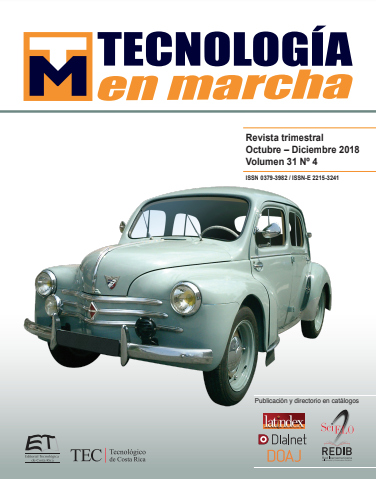Anaerobic stabilization of biodegradable solid waste for animal feed at Tecnológico de Costa Rica
Main Article Content
Abstract
Waste is an immediate cause of almost any human activity, and nowadays, due to consumers´ behavior there is a lot of waste generation, regarding amount and variety, which need to be managed. Consequently, this research focused on the evaluation of different treatments for the stabilization of biodegradable solid waste generated at the institutional restaurant from Tecnológico de Costa Rica, as an alternative to manage, use and re-value that waste through animal feed. The waste was stabilized through an anaerobic fermentation with Effective Microorganisms (EM) in three treatments that added different proportions of EM, semolina, and molasses. The ingredients were introduced in micro-silos for ten days to allow the fermentation. Then, the products were evaluated qualitatively for physical parameters, and quantitatively for nutritional composition and microbiologic parameters, such as fiber, protein, ashes and nitrogen-free extract percentage, as well as moisture, pH, Gross Energy and presence of Salmonella and fecal coliformes. The results showed that the stabilized waste was a product that qualifies as an energy source, with acid pH and absence of pathogenic microorganisms. It was also evaluated economically and environmentally in a hypothetical swine production case contextualized in Costa Rica. This evaluation resulted in a chance of managing wastes through a fermentation process and obtain revenues, comply with animal welfare and environmental legislation, and avoid certain environmental costs if not treated.
Article Details
Los autores conservan los derechos de autor y ceden a la revista el derecho de la primera publicación y pueda editarlo, reproducirlo, distribuirlo, exhibirlo y comunicarlo en el país y en el extranjero mediante medios impresos y electrónicos. Asimismo, asumen el compromiso sobre cualquier litigio o reclamación relacionada con derechos de propiedad intelectual, exonerando de responsabilidad a la Editorial Tecnológica de Costa Rica. Además, se establece que los autores pueden realizar otros acuerdos contractuales independientes y adicionales para la distribución no exclusiva de la versión del artículo publicado en esta revista (p. ej., incluirlo en un repositorio institucional o publicarlo en un libro) siempre que indiquen claramente que el trabajo se publicó por primera vez en esta revista.

